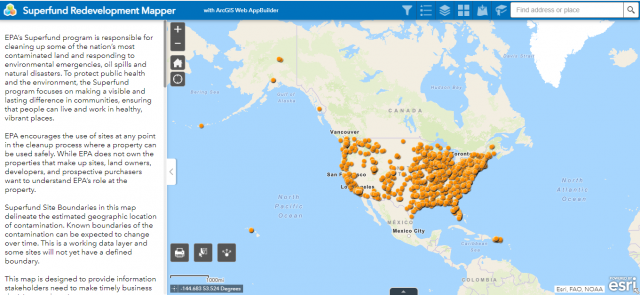Redevelopment Tools for Lenders

EPA’s willingness to work with purchasers and lenders and to use site-specific tools may help alleviate a lender’s potential concerns about financing the purchase of a contaminated property. The tools and resources below can assist lenders with site related information and decision-making.
- Mapping Applications
- Top 10 Questions to Ask When Buying a Superfund Site
- Revitalization Handbook – Revitalizing Contaminated Lands: Addressing Liability Concerns
- Fact Sheet: Updated Questions and Answers on the CERCLA Lender Liability Exemption
- Brownfields All Appropriate Inquiries
- Comfort/Status Letters Guidance
Mapping Applications
-

People use this mapping application to explore new development opportunities at Superfund sites. Search filters include Superfund site locations and related data layers, such as site details, community context, renewable energy potential, demographics, environmental conditions and infrastructure considerations. These features enable users to tailor reuse queries for specific areas and evaluate them quickly and easily.
- Opportunity Zones Mapper
The OZ Mapper includes:- Environmental, health, social, and economic data that are critical for understanding and advancing community revitalization goals.
- Data about each Opportunity Zone, such as the presence of brownfields, flood plains, impaired waters, air quality nonattainment areas, walkability scores, areas with limited access to food, and other data that might factor into a community's vision for redevelopment.
- Data from several government agencies, including EPA, Centers for Disease Control and Prevention, U.S. Census Bureau, and the Federal Emergency Management Agency, as well as a map feature that allows users to explore and visualize a broader group of data layers on health and environmental factors.
- Superfund Sites and Opportunity Zones StoryMap
This StoryMap provides information about how Opportunity Zone tax incentives can be used to redevelop sites. Redevelopment of current or former Superfund sites may qualify for Opportunity Zone tax benefits.
Documents and Other Resources
- Top 10 Questions to Ask When Buying a Superfund Site

Las 10 Preguntas Principales Que Hacer Al Comprar Un Sitio Superfund (PDF)
Las 10 Preguntas Principales Que Hacer Al Comprar Un Sitio Superfund (Puerto Rico) (PDF)
This document answers many of prospective purchasers’ most common questions when considering property acquisitions at Superfund sites.
- Revitalization Handbook – Revitalizing Contaminated Lands: Addressing Liability Concerns
The Revitalization Handbook discusses potential liability concerns associated with cleanup and reuse of Superfund sites and shares tools to address them.
-
Fact Sheet: Updated Questions and Answers on the CERCLA Lender Liability Exemption
Updated fact sheet highlights the main rules and EPA policy governing the Comprehensive Environmental Response, Compensation, and Liability Act (CERCLA, commonly referred to as Superfund) environmental liability for secured creditors for the cleanup of contaminated property. Issued July 2007. -
Brownfields All Appropriate Inquiries
All Appropriate Inquiries, or AAI, is the process of evaluating a property's environmental conditions and assessing potential liability for any contamination. - Comfort/Status Letters Guidance
EPA's comfort/status letter policy provides recommendations and model letters for EPA Regions to use when responding to parties interested in reusing and/or redeveloping contaminated, potentially contaminated, and formerly contaminated property (“impacted properties”).
